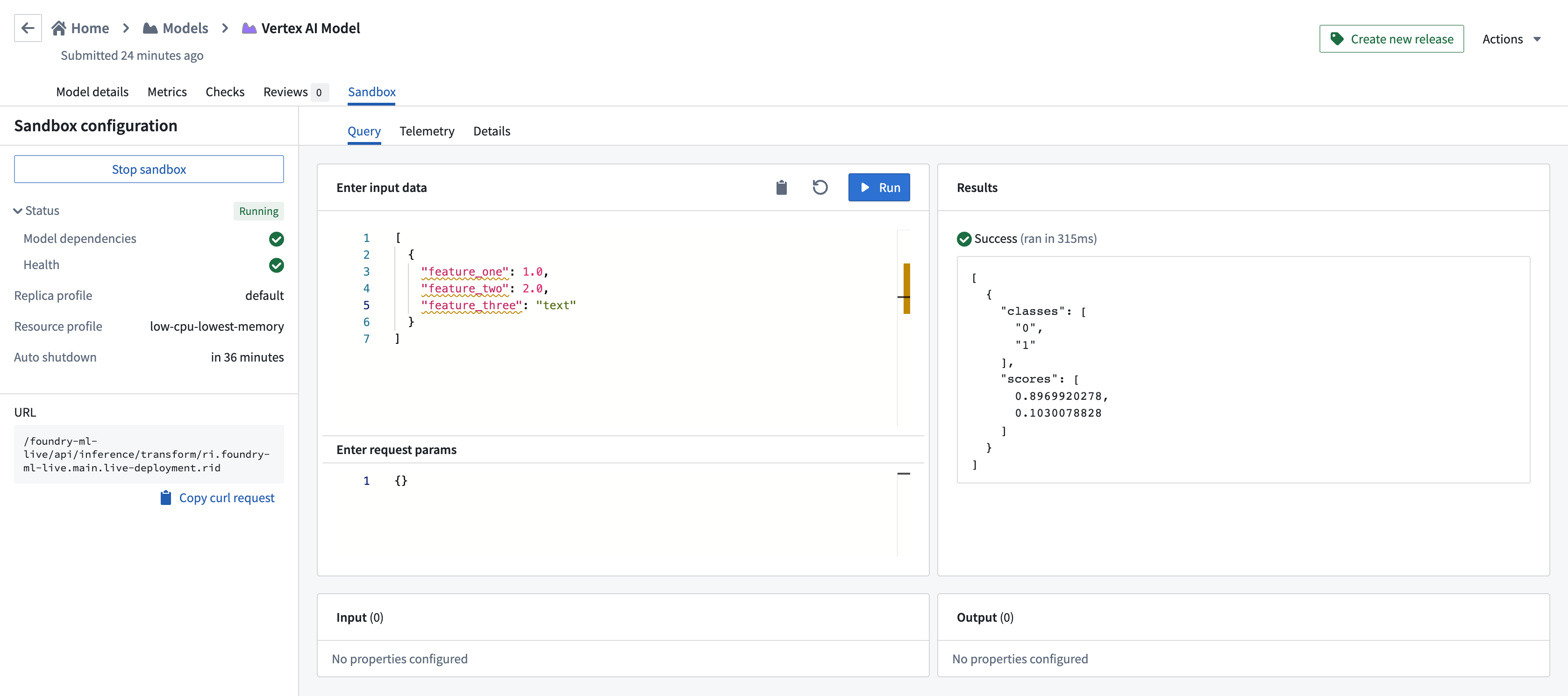Example: Integrate a Vertex AI model
The below documentation provides an example configuration and model adapter for a custom connection to a model hosted in Google's Vertex AI. Review the benefits of external model integration to make sure this is the right fit for your use case.
For a step-by-step guide, refer to the documentation on how to create a model adapter and how to create a connection to an externally hosted model.
Example Vertex AI tabular model adapter
First, publish and tag a model adapter using the model adapter library in the Code Repositories application. The below model adapter configures a connection to a model hosted in Vertex AI using the Vertex AI SDK for Python ↗ and framework. The below code was tested with versions Python 3.8.17, pandas 1.5.3,
google-cloud-aiplatform 1.32.0, google-auth 2.23.0, google-auth-oauthlib 1.1.0.
Note that this model adapter makes the following assumptions:
- This model adapter assumes that data being provided to this model is tabular.
- This model adapter will serialize the input data to JSON and send this data to the hosted Vertex AI model.
- This model adapter assumes that the response is deserializable from JSON to a pandas dataframe.
- This model adapter takes four inputs to construct a Vertex AI client.
region_name- Provided as connection configurationproject_id- Provided as connection configurationendpoint_id- Provided as connection configurationgoogle_application_credentials- Provided as credentials
Copied!1 2 3 4 5 6 7 8 9 10 11 12 13 14 15 16 17 18 19 20 21 22 23 24 25 26 27 28 29 30 31 32 33 34 35 36 37 38 39 40 41 42 43 44 45 46 47 48 49 50 51 52 53 54 55 56 57 58 59 60 61 62 63 64 65 66 67 68 69 70import palantir_models as pm import models_api.models_api_executable as executable_api from google.oauth2 import service_account from google.cloud import aiplatform from google.api_core import exceptions import json import pandas as pd import logging from typing import Optional logger = logging.getLogger(__name__) class VertexAITabularAdapter(pm.ExternalModelAdapter): """ :display-name: Vertex AI Tabular Model Adapter :description: Default model adapter for Vertex AI models that expect tabular input and output data. """ def __init__(self, project_id, region_name, endpoint_id, google_application_credentials): self.endpoint_id = endpoint_id # google_application_credentials is expected to be valid string representation of the Google provided # secret key_file credentials = service_account.Credentials.from_service_account_info( json.loads(google_application_credentials), scopes=["https://www.googleapis.com/auth/cloud-platform"] ) aiplatform.init(project=project_id, location=region_name, credentials=credentials) @classmethod def init_external(cls, external_context) -> "pm.ExternalModelAdapter": project_id = external_context.connection_config["project_id"] region_name = external_context.connection_config["region_name"] endpoint_id = external_context.connection_config["endpoint_id"] google_application_credentials = external_context.resolved_credentials["google_application_credentials"] return cls( project_id, region_name, endpoint_id, google_application_credentials ) @classmethod def api(cls): inputs = {"df_in": pm.Pandas()} outputs = {"df_out": pm.Pandas()} return inputs, outputs def predict(self, df_in): instances = df_in.to_dict(orient='records') try: endpoint = aiplatform.Endpoint(endpoint_name=self.endpoint_id) except ValueError as error: logger.error("Error initializing endpoint object double check the inputted endpoint_id, project_id and " "region_name.") raise error try: # Output from model is assumed to be json serializable # if result is too large for executor this may cause an OOM prediction_result = endpoint.predict(instances=instances) except exceptions.Forbidden as error: logger.error("Error performing inference provided google_application_credentials do not have sufficient " "permissions.") raise error except exceptions.BadRequest as error: logger.error("Error performing inference double check your input dataframe.") raise error return pd.json_normalize(prediction_result.predictions)
Vertex AI tabular model configuration
Next, configure a externally hosted model to use this model adapter and provide the required configuration and credentials as expected by the model adapter. In this example, the model is assumed to be hosted in us-central1, but this is configurable.
Note that the URL is not required by the above VertexAITabularAdapter and so is left blank; however, the configuration and credentials maps are completed using the same keys as defined in the Model Adapter.
Select an egress policy
The below uses an egress policy that has been configured for us-central1-aiplatform.googleapis.com (Port 443).
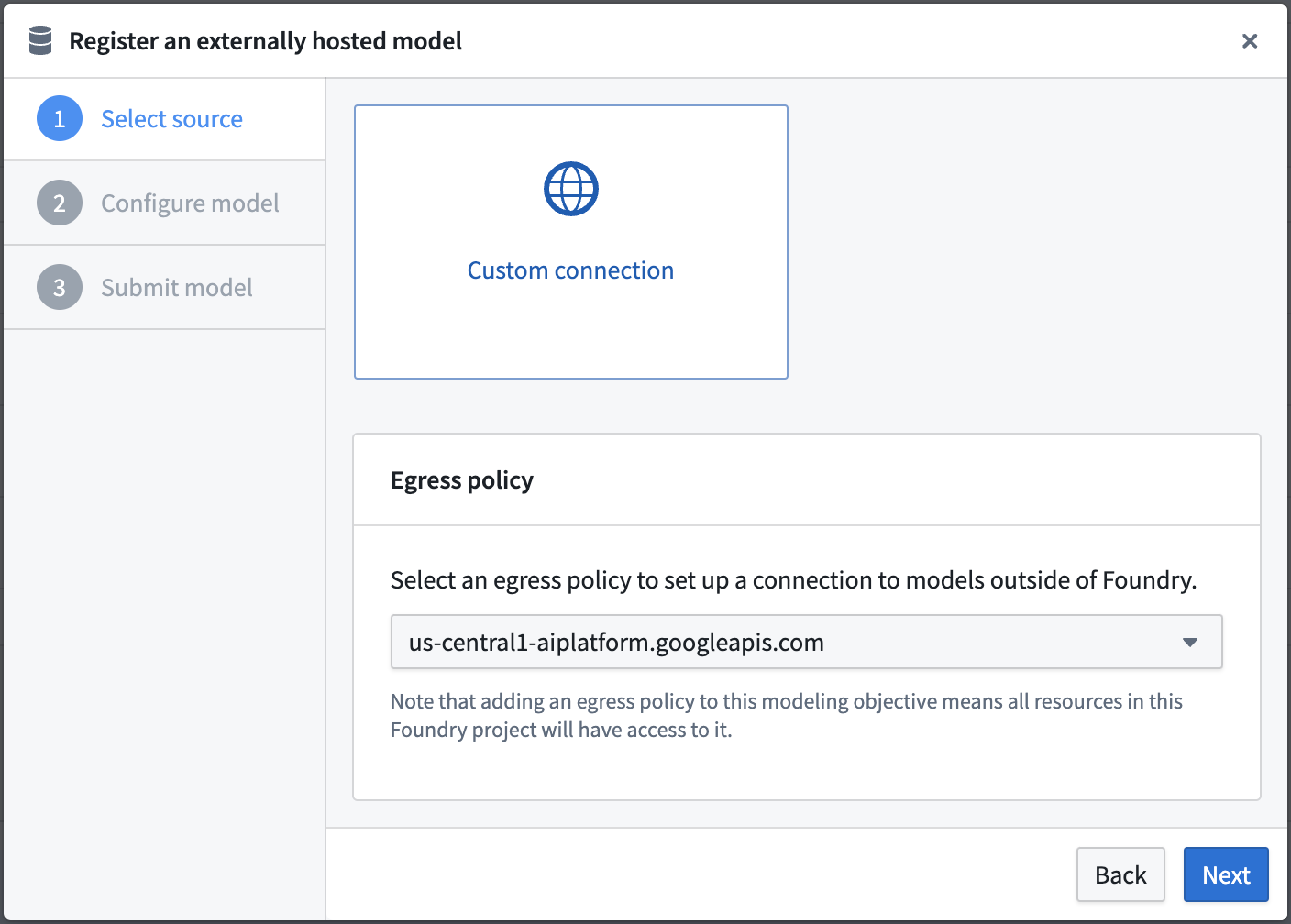
Configure model adapter
Choose the published model adapter in the Connect an externally hosted model dialog.
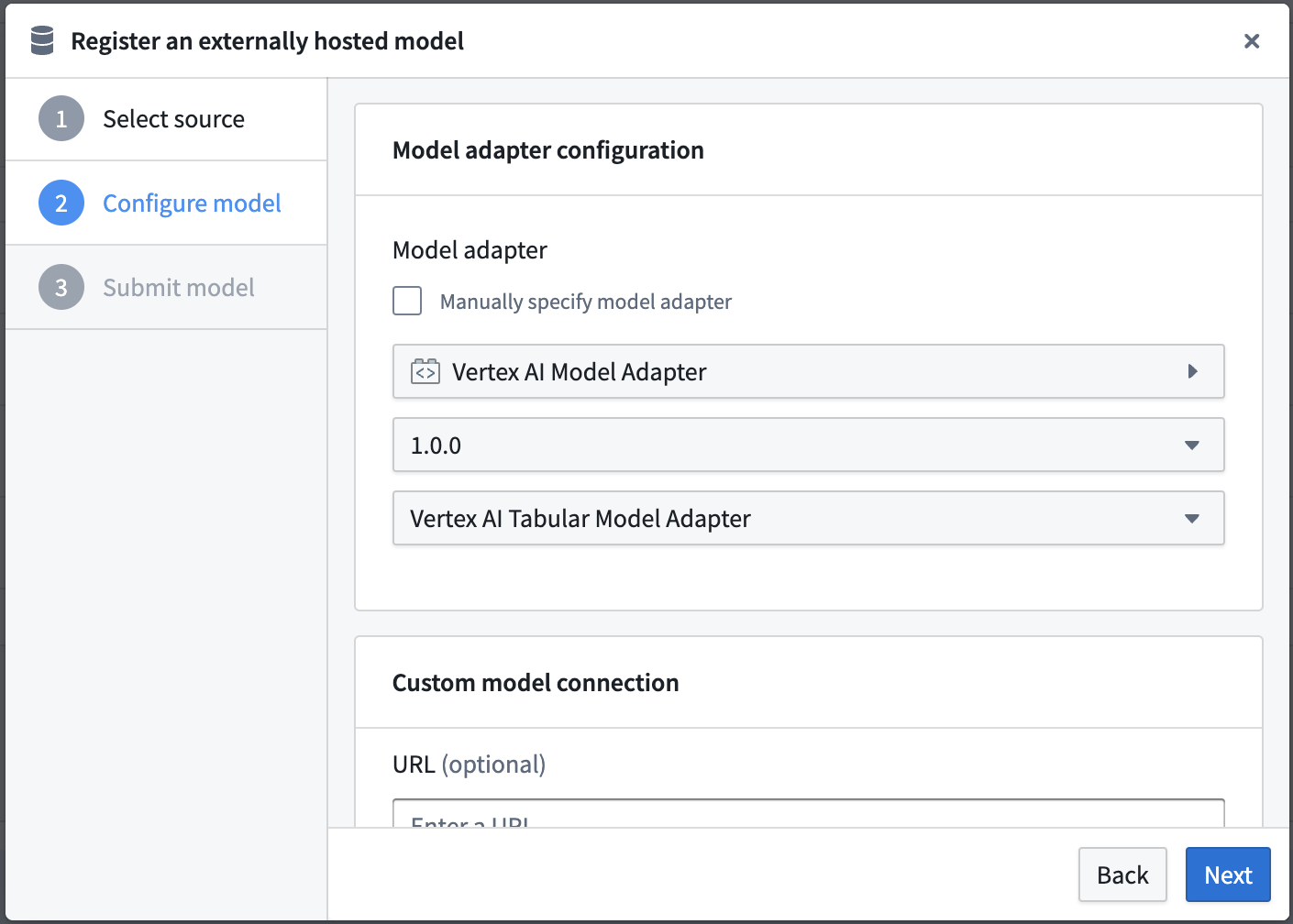
Configure connection configuration
Define connection configurations as required by the example Vertex AI tabular model adapter.
This adapter requires connection configuration of:
- region_name - The Google region name where the model is hosted.
- project_id - The unique identifier for the project this external hosted model belongs to.
- endpoint_id - The unique identifier for the externally hosted model.
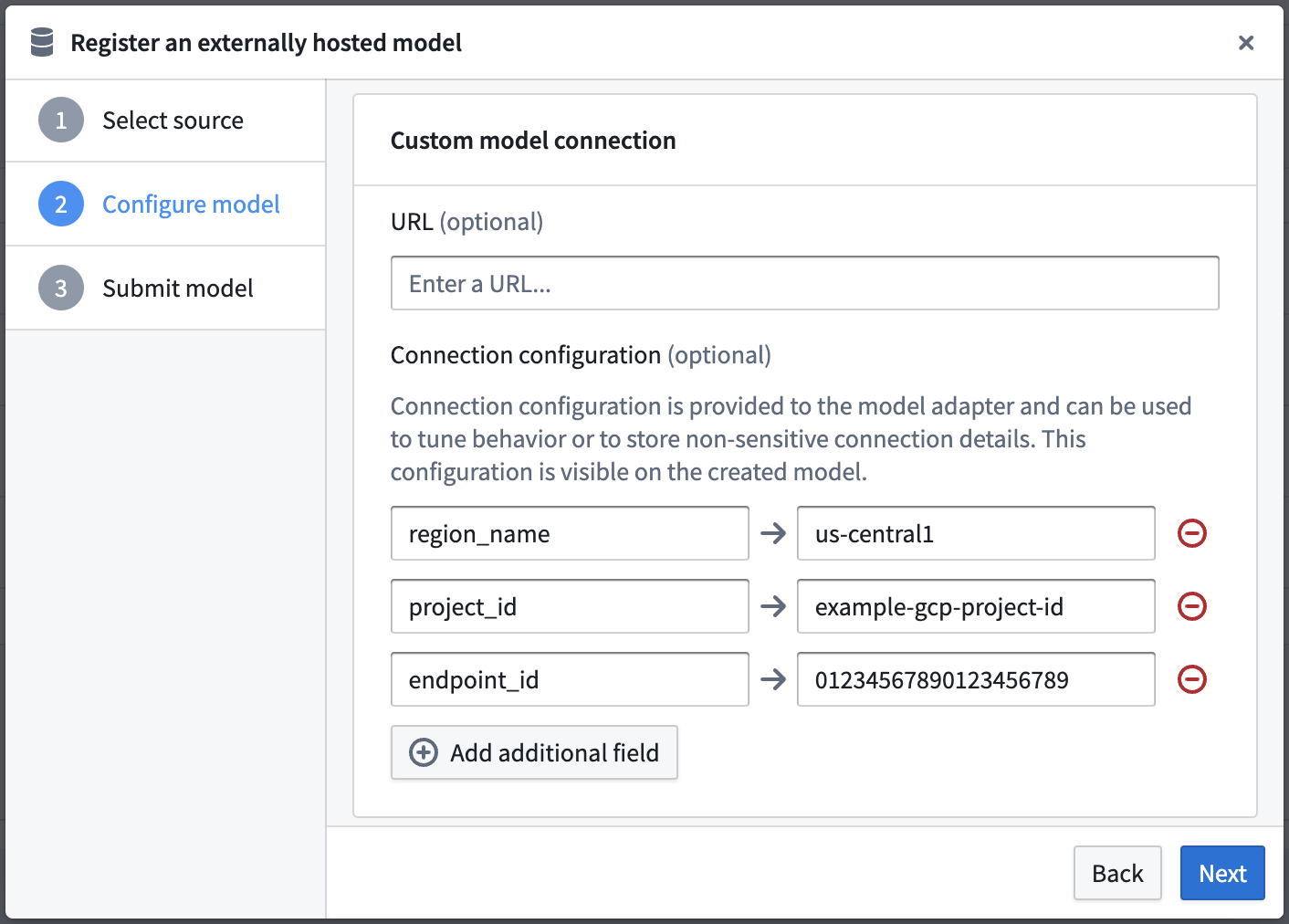
Configure credential configuration
Define credential configurations as required by the example Vertex AI tabular model adapter.
This adapter requires credential configuration of:
- google_application_credentials - This is the full contents of a service account private key file that can be used to obtain credentials for a service account. You can create a private key using the Credentials page of the Google Cloud Console ↗.
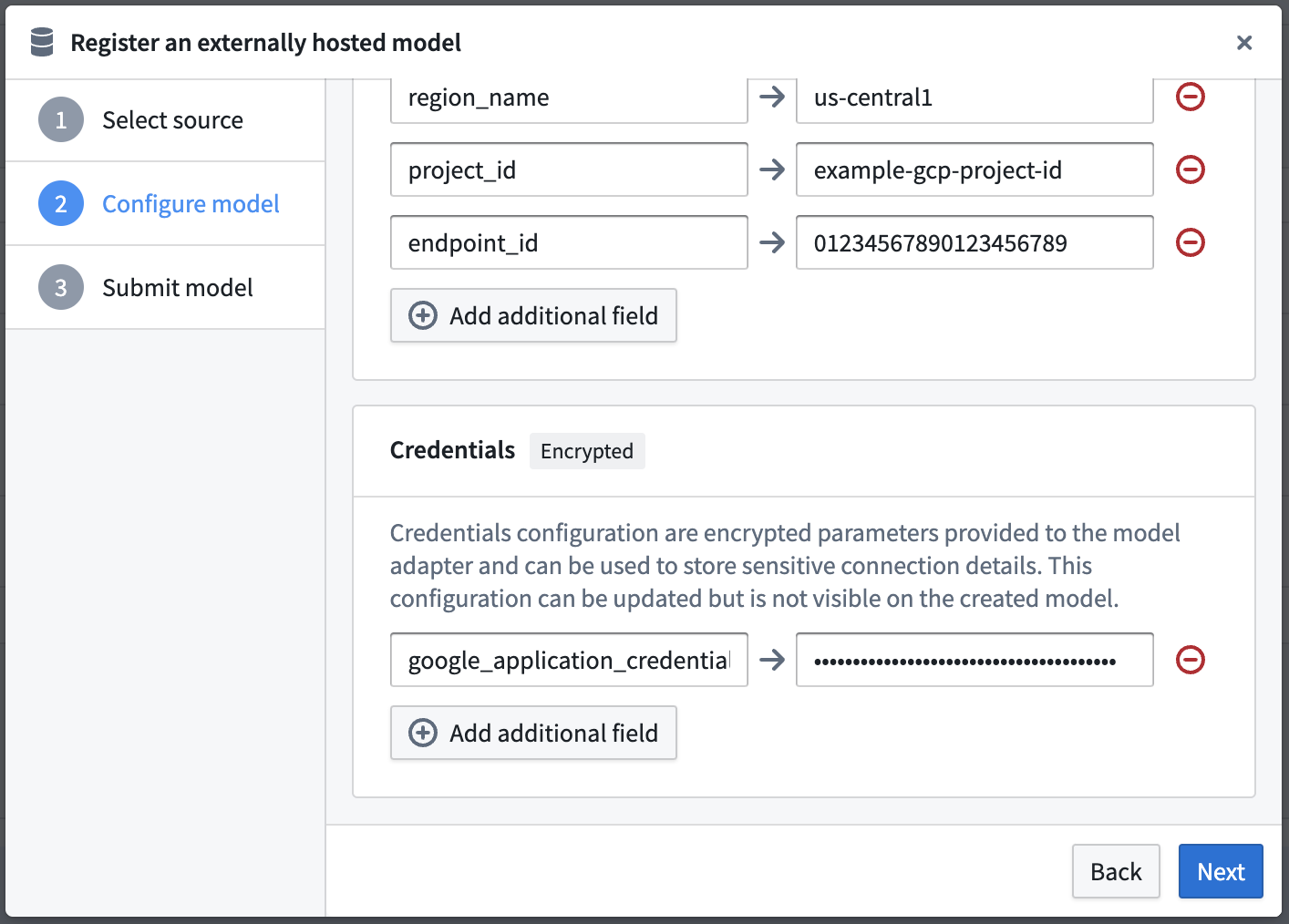
Vertex AI tabular model usage
Now that the Vertex AI model has been configured, this model can be hosted in a live deployment, or Python transform.
The below image shows an example query made to the Vertex AI model in a live deployment.
